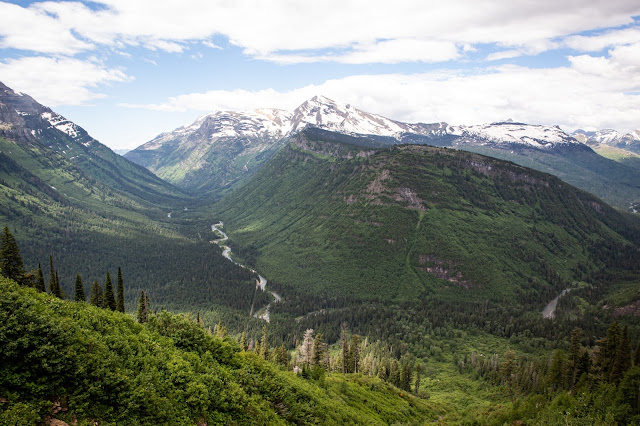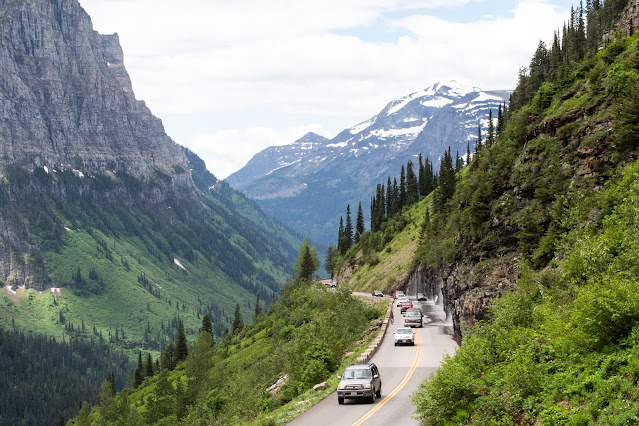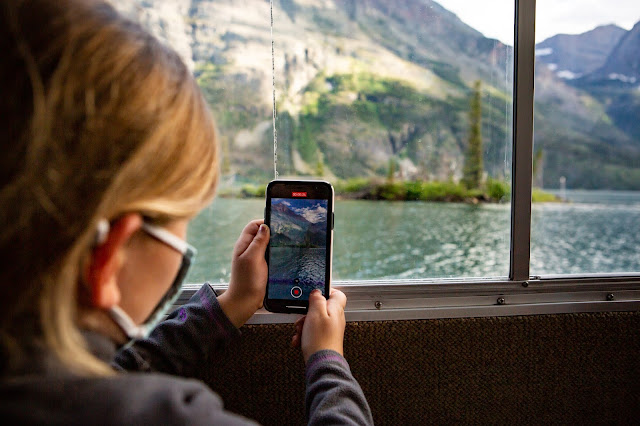Saturday, June 26, 2021
Friday, June 25, 2021
6.25.2021 The Going to Sun Road, St. Mary lake, celebrating #11
We literally cannot believe our luck!!!! The Going to the Sun Road opened today!!!
One of the most famous and picturesque roads in America did not disappoint with its jagged peaks, glaciers, lush forests and wildflowers, waterfalls and the animals all around. It was truly a magical day!
the tight turns and sheer drop-offs were truly harrowing. I am so thankful Jamie has a steady sense of driving!
One of the famed red buses on the road!
the weeping wall
Grazing bighorn sheep
We noticed this ram keeping an eye out.
What a view!
What a gorgeous place to spend your 11th birthday! Happy birthday, Juliette! She has spent her birthday in some pretty amazing places over the years!
The road crosses the Continental Divide through Logan pass. In 1921 construction began on this beautiful road and was completed in 1932. It is a National Historic Landmark and 50 miles long.
This road is typically open late June/early July to mid October and takes a long time to plow. They just push it over the edge! The chief engineer wanted to make a road that blended into the actual mountain itself and its famed stone barriers and switchback do in fact disappear from a distance. There are many hairpin turns and rock overhangs and we were thankful our car wasn't any bigger.
Saint Mary Lake
We were excited to spot a black (cinnamon colored) bear!
They are omnivores and were told they can spend up to 22 hours a day eating. They eat mostly grasses, leaves and fruit. They will also eat nuts, insects, honey, eggs and rodents and also carrion, young deer and elk when available.
They can also run up to 35 mph!
We had a boat tour scheduled for the evening so decided to take a quick hike. We had hoped to see St Mary Falls but parking was a problem. We parked near the lake and hiked to see Baring Falls and part of Sun Point Nature Trail.
There was a forest fire a few years ago so we had quite a different view. There were so many wildflowers and vegetation which is part of the life cycle of this park. The trees burn and offer vegetation to proliferate and grow and in turn giving many of the animals that call this park home a lot to eat.
The different colors of rock are from the different types of sediments and minerals from the Lewis Overthrust millions of years ago that are the mountains here today. The red and green are argillite and pale color rock is limestone.
It is interesting how the animals truly do coexist with the visitors to the park. Most of them seemed curious and then went back to what they were doing (grazing, walking, scurrying etc). I certainly didn't want to spook a bear or intimidate a moose and there were reports of attacks throughout bear country in the US. We had bear spray on us at all times.
A great way to learn about the park was to take a boat ride on one of the beautiful lakes of Glacier. We had a great tour guide who taught us about geology, animals, weather and about the park.
Wild Goose Island
The opening scene of "The Shining" by Stanley Kubrick was shot here.
Glacier National Park has a unique point called Triple Divide Peak in the Rocky Mountain range. It is a place where rain water flowing down the slopes ends up in three eventual places, The Pacific, Atlantic or the Arctic Ocean.
The major rock layers in the park start with the bottom being Altyn (limestone), then Appekunny (green argillite with quartzite banding, then Grinnell (red argillite (mudstone with quartzite banding) and then Siyeh (limestone with numerous fossilized algae colonies.
The Siyeh formation forms many of the mountain tops and cliffs seen.
All os this happened ab out 70 million years ago when the tectonic plates of the earth started building and shifting in the western part of North America.
Over millions of years, glaciers formed from snow packed piles when more snow falls then melts that chiseled and formed the various peaks and valleys and landscapes of this area.
A changing climate means that all the glaciers are shrinking every year. They predict that most if not all the glaciers will be melting in decades. Around 1850 the area had about 150 glaciers but now only 25 active glaciers remain today.
Glaciers shrink through naturally cycled climate change and also can be attributed to human greenhouse gas emissions. How fortunate we are to be able to see a glimpse of a few of the glaciers that are left!
The reason why the lakes in Glacier are so turquoise blue are from "glacier dust" which is rock sediment. When the sunlight reflects on the "rock flour" that is suspended in the water, it creates a vivid blue color. So the more glacier dust or flour in the lake...the bluer it appears!
Another Cinnamon colored black bear! It certainly has a teddy bear face!
Another view of Wild Goose Island.
Celebrating this girl turning 11! We had leftover pizza and a cake she picked out herself. We hope you had a wonderful day exploring Glacier!!!
Subscribe to:
Posts (Atom)
























































































































































